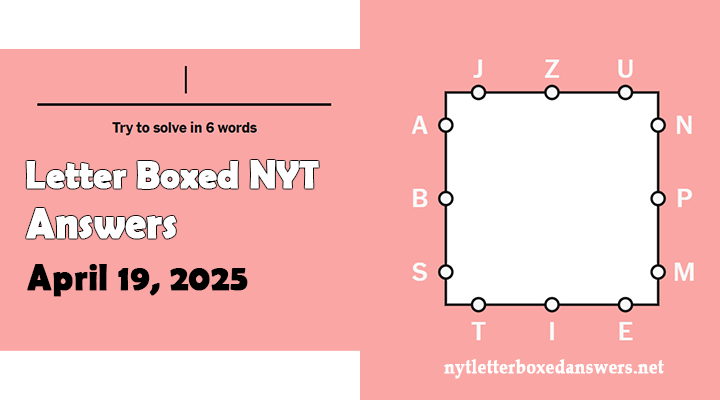NYT Letter Boxed quiz for Saturday April 19, 2025 is released. We came up with Letter Boxed April 19 2025 Answers and Hints for you. With the help of these hints, you will be able to guess the words of letter boxed quiz without revealing the answers and get the solution.
| Top | Right | Bottom | Left |
|---|---|---|---|
| JZU | NPM | TIE | ABS |
| Two Words Solution | ||
|---|---|---|
| JAPANIZES | SUBMENTA | |
| JAPANIZES | SUBMENTUM | |
| Three Words Solution | ||
|---|---|---|
| AMAZES | SUPINE | ENJAMBMENTS |

Word 01:
This word has 9 letters, starts with J, and ends with S.
A verb that means to adapt or influence with Japanese culture or characteristics.
Similar in structure to “westernizes” but in an Eastern direction.
Often used in cultural or artistic transformations.
Can refer to aesthetic changes inspired by Japan.
Includes a country’s name within it.
Ends with a common verb suffix “-izes.”
Describes a process of cultural assimilation or stylization.
Might apply to fashion, design, or architecture.
The action could be metaphorical or literal in cultural studies.
Word 02:
This word has 8 letters, starts with S, and ends with A.
Plural anatomical term referring to parts under the mentum (chin).
Used mostly in entomology for parts of an insect’s mouth.
Rare in daily language but common in scientific contexts.
Related to Latin terms for “under” and “chin.”
Might be seen in diagrams of beetle or ant anatomy.
The singular version of this word ends in “-um.”
Found in taxonomy and identification keys.
Could be used in biological research or lab settings.
Appears in niche glossaries or medical textbooks.
Word 01:
This word has 9 letters, starts with J, and ends with S.
A verb that means to adapt or influence with Japanese culture or characteristics.
Similar in structure to “westernizes” but in an Eastern direction.
Often used in cultural or artistic transformations.
Can refer to aesthetic changes inspired by Japan.
Includes a country’s name within it.
Ends with a common verb suffix “-izes.”
Describes a process of cultural assimilation or stylization.
Might apply to fashion, design, or architecture.
The action could be metaphorical or literal in cultural studies.
Word 02:
This word has 9 letters, starts with S, and ends with M.
Refers to a single part beneath the mentum in an insect.
Typically mentioned in anatomical descriptions.
Singular version of “submenta.”
Found in head structures of some invertebrates.
A technical word, not used in general speech.
Has Latin roots and scientific application.
May come up in dissection notes or taxonomic descriptions.
Describes a structural support area in entomology.
Essential for detailed insect morphology studies.
Word 01:
This word has 6 letters, starts with A, and ends with S.
A verb that means to greatly surprise or impress.
Commonly used to express astonishment or admiration.
Often follows “it” or “she” in casual speech.
Related to feelings of awe or disbelief.
Synonym of “astounds” or “stuns.”
Opposite of “bores” or “disappoints.”
Regularly used in performance or reaction contexts.
Derived from Middle English.
Can describe either emotional or factual surprise.
Word 02:
This word has 6 letters, starts with S, and ends with E.
Describes lying flat on the back, face upward.
Used in medical and anatomical descriptions.
Contrasts with the “prone” position.
Can also mean passive or yielding in behavior.
Comes from Latin meaning “bent backward.”
Often heard in physical therapy or yoga.
Not just physical—can refer to personality too.
Appears in formal English, especially in health or psychology.
Rhymes with “divine” in some accents.
Word 03:
This word has 11 letters, starts with E, and ends with S.
A poetic device where a sentence flows beyond the end of a line.
Opposed to end-stopped lines in structure.
Enhances rhythm, pacing, or surprise in poetry.
Common in free verse and modern poetry.
Derived from the French word meaning “to stride over.”
Can create suspense or emphasis across stanzas.
Helps link ideas visually and rhythmically.
Requires the reader to continue to the next line for meaning.
Often used in contrast to traditional meter or rhyme schemes.

Chris Brown is a passionate word game love and problem solving expert. With over 15 years of experience in solving puzzle challenges, he provides daily NYT Letter Boxed answers, tips and strategies to help other players so that they can improve their solving skills. Whether you are stuck on a tricky puzzle or looking for new techniques, Chris is here to guide you with his expert solutions.